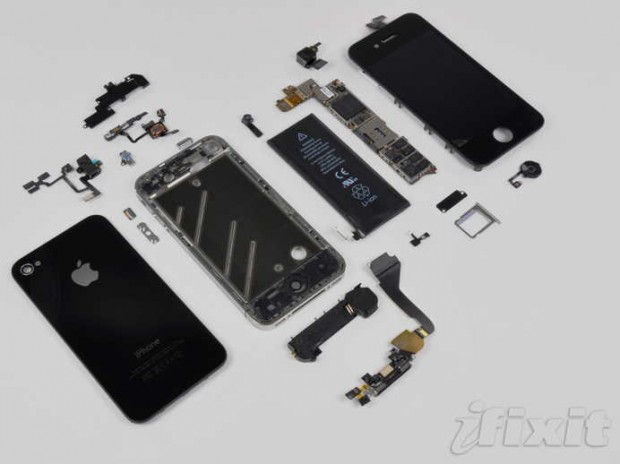
iFixIt has their traditional teardown posted. After analyzing every picture, a few things are noteworthy:
Stainless Steel Antenna
The stainless steel antenna strikes me as more than just an antenna, but Apple will never admit it. The iPhones before all suffered from the same structural weakness. If dropped so that it lands on a corner or a side, the body flexed putting pressure on the glass and possibly digitizer if the impact was strong enough. This resulted in the shattered glass you sometimes see people walking around with. If the phones land on their backs or faces, they are often fine minus a tiny scratch or two. This is because the sides of earlier models were not very strong. The metal band you see on the earlier models isn’t enough to hold up to the force of a drop from 5 feet. It was a thin piece of stainless steel around what is otherwise plastic. Most of the metal in the previous phones are actually thin EMF shields, not anything structural.
I suspect this new frame also serves to strengthen the phone and prevent this type of damage.
Creative EMF Shielding
The previous iPhones pretty much just had a large EMF shield like we see in most consumer appliances. The new iPhone has a bunch of tiny EMF shields. The advantage to this approach is that they can cram more things into small nooks and crannies. Apple is clearly desperate for every nanometer of space they can get.
No Surprise Chips
Nothing inside circuitry wise is even remotely surprising. Samsung flash memory, Broadcom WiFi, Bluetooth (BCM4329), Cirrus Logic audio codec, TriQuint/Skyworks GSM/GPRS chipset, STMicro accelerometer. The new gyroscope is suspected to be STMicro, which isn’t shocking. There is a Broadcom GPS (BCM4750) chip, same as the iPad. Prior to the iPad, the iPhone 3G and 3GS used an Infineon Hammerhead GPS chip which was questionable in performance. Perhaps this will finally give the performance necessary for eventually making turn by turn directions a reality.
Battery Technology Needs To Improve
It’s becoming clear looking at the iPhone 4 that Apple made the right decision to make the battery non-removable. The hardware and extra material to make it removable would have really bulked up the phone. At this point the battery is by far the biggest single space consumer in the iPhone. Look how dense the circuitry for the phone is in comparison to the hulk sized battery. Apple crammed what a few years ago was a full PC into that sliver on the side of the phone. The rest is largely the battery with glass and LCD in front and various speakers, microphones, cameras and sensors mixed in the otherwise empty nooks.
Apple really needs to find a technology that can offer a higher power density ratio for the iPhone to get any lighter or longer battery life. Custom silicon will help them, but it’s only going to go so far and so fast. It’s becoming obvious that power is a major concern and limitation for Apple engineers. I suspect Apple spends a ton of R&D time and money trying to figure out how to deal with this limitation the best they can from the physical space requirements to power efficiency and software innovations.
Don’t be shocked if Apple either invests or just acquires a company who is doing something interesting in the battery space just like they picked up P.A Semi.
Environmental Stats
Apple hasn’t published their environmental report yet on the iPhone 4. I’m curious how the greenhouse gas emissions changed between the iPhone 3GS and iPhone 4. Several things have changed about its composition including the glass and steel frame that should make it interesting. The iPad’s slightly different (and larger) power adapter boasts an 80% efficiency rating. The iPhone 3GS is only in the 70% range. I’m curious if Apple quietly updated the adapter at all or not (I suspect not, but it’s possible).
Image courtesy iFixIt
